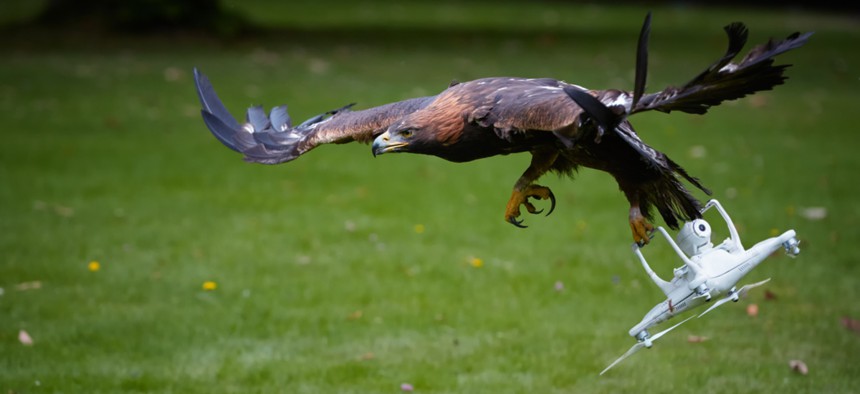Humans Made Drones by Copying Birds. Birds Are Fighting Back.

Martin Mecnarowski/Shutterstock.com
As machines fill the skies, they meet resistance from the animals who already live there.
In the National Gallery of Australia’s permanent collection is a painting by Sidney Nolan titled The Alarm. One in a series of artworks chronicling the downfall of the Kelly gang—infamous outlaws of the late 1800s—it depicts a radiant peacock encountering a policeman. Peacocks, the painting’s interpretive text explains, were in those days sometimes dragooned as sentries. The birds can sight a threat two miles away and tend to shriek in panic. A person wishing to protect his property might have used one as an early-warning system—a telescope and Klaxon rolled into one.
Today, a bird’s-eye perspective is exploited by nefarious enterprises and law enforcement alike, in the form not of a peacock, but of a drone. Drone innovators have made a close study of the biomechanics and behaviors of birds. Motorized load-grippers take inspiration from the grasping motion of raptors’ legs, and camera-lens designers strive to replicate the acuity of eagles’ eyes. To model wing aerodynamics, engineers at Stanford University have flown tiny parrots in tiny protective goggles across a laser field suffused with aerosolized particles. Other researchers have used drones to study the complex undulations (known as “murmurations”) made by groups of starlings, while scientists in Europe have looked to the in-air coordination of pigeon flocks for ideas about how drones might tweak their flight paths alongside one another.
Beyond improving drone functionality, biomimicry can abet drone subterfuge. In June, the South China Morning Post reported on a new generation of inconspicuous “dove” drones used to monitor citizens in at least five Chinese provinces. These quiet, lightweight drones (complete with flapping wings) purportedly go unrecognized even by animals. One developer has described deliberately testing them near sheep, which, despite being generally skittish and alert to novelty in their environment, were oblivious of the robots overhead.
Ever greater numbers of drones are entering the airspace not just as tools of surveillance but as instruments of commerce and as playthings. This has led to an interesting moment. The airspace that drones occupy is far from empty; it is habitat. What lives there may be unwilling to cede its territory.
Australia, with its expansive terrain and favorable weather, is well appointed as a natural laboratory for commercial drone testing. But drone operators on this continent encounter a hazard that tracks their technology from above and descends on it with destructive intent: the wedge-tailed eagle, which has taken to skirmishing with drones. Videos captured from the drone’s-eye perspective have proved popular online—a subgenre of nature-fights-machine. Such footage inevitably ends in a flurry: talons ripping at the drone’s carbon-fiber frame, a whirling fall, then hard impact. In Western Australia’s goldfields, a single mining company reported that eagles had inflicted more than $70,000 worth of damage to its surveyor drones.
In the future, companies planning delivery networks of drones will need to factor in the risk of such hostilities. Some surveyors operating in eagle habitats have reduced, though not eliminated, damage to their drones by avoiding the warm air currents favored by wedge-tailed eagles. But other birds, including hawks and even geese, are also on record attacking drones. If consumer drones are to play a successful role in e-commerce, designers tasked with camouflaging them from other species will be compelled to imagine different perceptual realities (for example, eagles’ eyes see individual rotor blades where human eyes register a blur). They may have to find new ways of disguising machines, making drones appear and sound as innocuous as songbirds (or, taking a cue from the Chinese, doves) in the hope that they are less conspicuous. So drones may come to look even more avian, not to hide from us but to avoid aggressive birds.
In the interim, the territorial instinct of eagles has been identified as a potential asset, first by the Dutch and now by other European authorities: The French and the Swiss are training eagles to bring down errant or hostile drones. As peacocks were once sentinels, so eagles may in time become tools of our countersurveillance.


